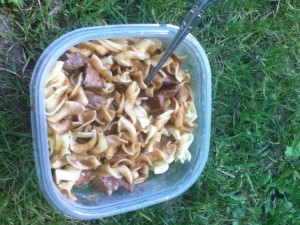Good morning everyone, and Happy Tuesday! To start off the day right I first drank a glass of water to somewhat curb my growling morning stomach…just so I didn’t eat everything in sight once I opened the fridge. The drinking water in South Surrey comes from one of Coquitlam, Capilano, or Seymour’s watersheds, which collects water from local sources; the water passes through a complex series of tunnels, reservoirs and treatment plants before coming out of the tap. This long transportation route uses pipes for transporting the water, which were produced by machines powered by oil and electricity. Honestly, at the first thing in the morning, none of this even came close to crossing my mind, I was having enough trouble keeping my eyes open let alone think of where my water was coming from. Breakfast Next on the menu was fixing some breakfast to take with me on the daily commute to work! I boiled some water with an electric kettle, and made some hot chocolate mixed with instant coffee powder. Both the hot chocolate mix and instant coffee were products from Nestlé; Nesquick Hot Chocolate and Nescafe Instant Coffee. The Instant coffee is a product of Brazil; However Brazil can provide me with a boost to start my morning in Canada, they struggled to do the same for their soccer team….  (The metro newspaper, July 9, 2014) Nescafe works hard to ensure sustainable agriculture on their coffee farms, providing the farmers with modern technology, which run off of oils and fossil fuels, to increase production and the lifeline of their farms. “Heavy ‘Bulker’ Fuel’ is used in the processing stages of production of the coffee. On their website, Nestlé claims they are working towards alternative sources to getting their energy, trying to become less dependent on fossil fuels. This is good news, but still the transportation and distribution of their products, such as large barges or airplanes, will still rely heavily on fossil fuels – even if the company changes their energy sources. (Here is the website http://www.nescafe.com/farming_en_com.axcms) Accompanying this drink, I grabbed a peanut butter and jam sandwich on the way out the door. Although it’s not the most nutritious, it was quick and I was able to eat it on the bus without getting food everywhere. The jam I used was homemade blackberry jam from my family friends in Castlegar. They picked the black berries from their neighbourhood, and made the jam in a large batch in their kitchen! The form of energy used in the production of the jam was mainly human muscle, but there was also the electricity from their stove, and then I suppose the oil in their car from when they brought it out to our house. It tasted delicious, and of course much better than store bought brands. The peanut butter on the other hand, was store bought, Skippy Smooth. I wasn’t able to find the exact location of where the peanuts were grown, but they could be either grown in Georgia, Texas, Florida, or Oklahoma. The peanuts were shelled using a shelling machine, their plant in the US, which replaces the need for human power to shell the nuts with mechanical power (essentially oils). Once again, lots of fossil fuels were used in the stages leading to the peanut butter being gratefully spread on my sandwich. (http://www.unilever.ca/brands/foodbrands/skippy.aspx)
(The metro newspaper, July 9, 2014) Nescafe works hard to ensure sustainable agriculture on their coffee farms, providing the farmers with modern technology, which run off of oils and fossil fuels, to increase production and the lifeline of their farms. “Heavy ‘Bulker’ Fuel’ is used in the processing stages of production of the coffee. On their website, Nestlé claims they are working towards alternative sources to getting their energy, trying to become less dependent on fossil fuels. This is good news, but still the transportation and distribution of their products, such as large barges or airplanes, will still rely heavily on fossil fuels – even if the company changes their energy sources. (Here is the website http://www.nescafe.com/farming_en_com.axcms) Accompanying this drink, I grabbed a peanut butter and jam sandwich on the way out the door. Although it’s not the most nutritious, it was quick and I was able to eat it on the bus without getting food everywhere. The jam I used was homemade blackberry jam from my family friends in Castlegar. They picked the black berries from their neighbourhood, and made the jam in a large batch in their kitchen! The form of energy used in the production of the jam was mainly human muscle, but there was also the electricity from their stove, and then I suppose the oil in their car from when they brought it out to our house. It tasted delicious, and of course much better than store bought brands. The peanut butter on the other hand, was store bought, Skippy Smooth. I wasn’t able to find the exact location of where the peanuts were grown, but they could be either grown in Georgia, Texas, Florida, or Oklahoma. The peanuts were shelled using a shelling machine, their plant in the US, which replaces the need for human power to shell the nuts with mechanical power (essentially oils). Once again, lots of fossil fuels were used in the stages leading to the peanut butter being gratefully spread on my sandwich. (http://www.unilever.ca/brands/foodbrands/skippy.aspx)
Lunch (later)
Due to the volume of tasks I had to finish at work, I didn’t get out to lunch until around 1pm, so it was a lot later than usual, and my stomach was ready for some good food. On the menu for my lunch in the park was left overs, consisting of egg noodles with pork chops. Both of these food items were bought from save-on foods. The noodles were from the brand Catelli, with their main factory based in Montreal, Quebec. Upon further investigation into the noodles, I found that Catelli is one of the major pasta producers for consumers in Canada, and they introduced a new production line in their company quite a few years ago, so I am guessing they have only expanded even more since. Pasta is produced in a series of steps, and heavily involves the use of mechanical machines, for example mixing machines with rotating blades, a laminator, a vacuum-mixing machine and an oven. (http://www.madehow.com/Volume-2/Pasta.html)

As for the pork chops, I am not certain of where they are from. Knowing they were bought from Save-On, I can assume the meat came from a slaughter house. The process of feeding the animals, transporting the animals from the farm to the slaughter house, killing them, processing the meat, and then transporting it further all the way to the grocery store uses a lot of oil energy in the form of machinery.
Dinner (snack)
After having a late lunch, I when dinner time came around I decided to have just a snack; it was late anyways so I wasn’t too hungry. I enjoyed a couple apples, with the code 4133. The code begins with a four, so that means that it is conventional produce, and not organic or genetically modified, but it probably has some pesticides on it, if they were sprayed on the trees. The apple came along ways from its home in New Zealand to make it to my house.
The apple trees were most likely fertilized, and since it probably came from a large farm the fertilizer was probably sprayed from a machine rather than hand sprinkled – possibly by a tractor or a small plane depending on the size. Pickers would harvest the apples, and sort them, the apples would then need to be stored and cooled during their transportation to Canada.
Overall, I would say my diet was quite oil rich on Tuesday. Despite thinking I was eating quite healthy, it turns out it was rather packed with oil. Some main points that I often overlook while purchasing food is focusing on the transportation and packaging required to get the food from point a to b. Packaging the produce in plastic bags or cartons requires that lots of energy was used to produce the packaging itself, let alone its contents. Also transportation is another main point. I will definitely be more aware of where my food is coming from now.